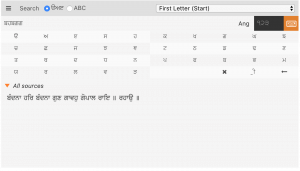

There is a bisraam after “har”, as in “hari (ne), jee guffa (de) andar rakh ke.”. It actually means that Vaheguru places the soul(jeeo) into this body cave. The Lord placed the soul to the cave of the body, and blew the breath of life into the musical instrument of the body.įor most of my life I had been reading this all together and thought “Har Jeeo” meant “Respected Lord”. This is the same for all of the other lines in this padhaa of Sukhmani Sahib. But one sat is for charan, the other is for parsanhar. Many people read these together as one word, like “Charan SatSat Parsanhar”. His Lotus Feet are True, and True are those who touch Them. Most of the lines in this pauri have the bisraam after “Ko”. It should be “Gaavai Ko, Jee Lai Phir De”. If we put the bisraam after jeea, or the third word in every line of this pauri, as is commonly done, we would say “some sing of life, takes then gives.” Clearly “take” goes with “life”, so they should be together as one phrase. Some sing that He takes life away, and then again restores it. I have added spaces in the lines to signify where a pause “should” be. Some of these I have observed during kirtan or paath, while others I have learnt from my father or other Gursikhs. The following is a list of some common bisraam mistakes that people usually make because they aren’t often discussed or are easily overlooked. Fortunately, knowledgeable Gursikhs will often correct us so that we can sing it properly. Ideally we should have read and understood the shabad before singing it. Some times we sing a line for the first time on stage, without knowing the correct pauses and just separate it according to the tune or taal. Even if it doesn’t make a huge difference to the meaning, it is still important because we are supposed to be using music as a tool to bring out the mood and meaning of a particular pangti (line). Unfortunately most of us do the latter, often without realizing it. This is especially important for Keertanis – they should create and adjust their tunes based on the Shabad, rather than fit the Shabad to the tune. However, we should still make our best effort.

We may not always be correct, because our understanding is limited and Gurbani is above and beyond our intellect. Typically there we can tell if the meaning is contrary to Gurmat and therefore not likely. We can rely on research and translations of previous Gursikhs and the context of the shabad to try our best to understand where the pause is. Sometimes it is not clear or there are conflicting translations. So how do we know where the bisraam is? Usually our doubts can be cleared by stopping and doing vichar on the meanings of the lines or reading some steeks/meanings. If we put the bisraam after ghar and say “Gur Arjun Ghar, Gur Raam Daas.” it would mean that Guru Raam Daas ji was born into the house of Guru Arjun Dev Ji, which doesn’t make any sense! In the House of Guru Raam Daas, the devotee of the Lord, Guru Arjun was born. “Roko, na Jaan deo” – Stop them, don’t let them go.Įxample from Gurbani (commas added for illustration):

what should you do while reading Gurbani?


 0 kommentar(er)
0 kommentar(er)
